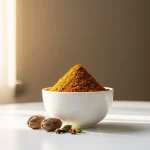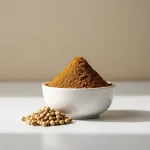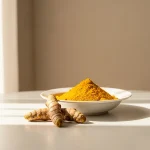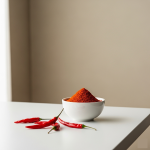
Navaratri is a nine-day celebration of the feminine that brings families together, fills kitchens with wonderful aromas, and highlights a variety of traditional dishes. Each day honors a different form of the Goddess and features a special prasadam made with simple ingredients, often carrying its own story or significance. From light snacks to sweet treats and wholesome meals, these foods are an essential part of the festival. Here’s a closer look at the dishes typically prepared on each day of Navaratri.
Day 1 – Chickpea Sundal
The festival begins with Chickpea Sundal on the first day. Light and nourishing, the chickpeas are tossed with cumin powder, coriander powder, and a touch of raw mango powder, creating a slightly tangy and mildly spiced snack. It’s a simple dish that’s filling and easy to prepare, perfect for a busy day of celebrations. Some people like to add grated coconut for extra texture and flavour.
Day 2 – Allam Garelu
Allam Garelu, or ginger-flavoured vadas, are prepared on the second day. These fritters, crisp on the outside and soft on the inside, have a warm and slightly spicy taste. They are light and satisfying, and making them fresh in the morning fills the kitchen with a festive aroma, setting the mood for the day ahead. With our instant vada mix, each bite brings a perfect balance of crunch and flavour, making them a much-loved prasadam during Navaratri.
Day 3 – Daddojanam
Daddojanam is a simple and soothing dish made with a hint of dry ginger powder. Soft and mildly spiced, it is easy to digest and feels light, satisfying and perfect for a Navaratri prasadam. The gentle warmth of the ginger adds depth to the dish, balancing its naturally subtle flavours. Many families enjoy serving it as part of a meal, making it both fulfilling and traditional.
Day 4 – Rava kesari
Rava Kesari is offered on the fourth day, marking a moment of sweetness and joy in the middle of the celebrations. This prasadam is often seen as a way to invite positivity and warmth into the home. Preparing it on this day is a simple way to pause, reflect, and share something sweet with everyone, setting a happy tone for the rest of Navaratri.
Day 5 – Poornam Boorelu
Poornam Boorelu are sweet lentil dumplings with a crisp golden coating and a soft, melt-in-the-mouth center. The mix of jaggery and lentils gives them a natural sweetness with a slight nutty flavours. These treats are often made in generous batches and shared with neighbors and family, spreading the festive joy. Though they take a little time to prepare, the process feels like a true celebration, filling the kitchen with warmth.
Day 6 – Pulihora
Pulihora, or tamarind rice, is one of the most loved prasadams of Navaratri. Tangy and flavourful, and quick with our instant pulihora mix, it is seasoned with curry leaves, cumin, and mustard seeds, giving it a perfect balance of tanginess, a hint of sweetness, and gentle heat from the spices. Quick to make and easy to share, this dish is a festival favourite that brings everyone to the table.
Day 7– Laddu
Laddus hold a special place in festivals, symbolizing prosperity and celebration. Their sweetness adds joy to the day and keeps the festive spirit alive through the nine days. Making laddus together at home often becomes a family activity, with everyone helping in small ways, turning it into a moment of togetherness. They also serve as a quick energy boost during the busy days of puja and festivities.
Day 8 – Atukulu
On the eighth day, Atukulu (poha) is often prepared as prasadam. Cooking it with milk and jaggery and garnishing with dry fruits turns it into a traditional sweet that feels both simple and special. An unpopular choice includes preparing tamarind pulihora with atukulu, and using an instant tamarind mix makes it quick while still keeping the familiar festive flavours. Both versions capture the spirit of this day — light, balanced, and nourishing — and are perfect for sharing after pooja.
Day 9 – Panakam and Pakam Garelu
Saraswati Devi is honored on the eighth day with Panakam and Pakam Garelu. Panakam, made with jaggery and cardamom, is considered refreshing and is believed to bring balance and focus to the mind. Pakam Garelu are often prepared fresh in the morning, and using an instant vada mix can make the process easier while still keeping the traditional touch. Together, they remind us to approach learning and creativity with both clarity and dedication, making this day special for students and families alike.
Day 10 – Maha Naivedyam
The festival concludes with Maha Naivedyam on Dussehra. This grand offering often includes nine dishes — rice, pappu, a simple curry, traditional sambar, vegetable kootu, tomato rice, pulihora, crispy vada, aromatic rasam, and payasam. Each dish adds its own touch, creating a meal that ranges from tangy and spicy to sweet and comforting. Preparing this feast while performing pooja and spending time with loved ones can be quite the task, so using handy helpers like koora podi, sambar powder, and kootu mix can enhance flavours without taking away from tradition. Instant pulihora, tomato rice, and vada mixes can save time, letting you focus on what truly matters — celebrating togetherness and marking the close of Navaratri with a meal that feels festive and abundant.
Closing Thoughts
Navaratri prasadam is simple, flavourful, and satisfying. From light, tangy snacks to sweet treats and hearty meals, these dishes are easy to prepare with everyday ingredients and bring a festive spirit into the home. Each recipe has its own charm and can be adapted to modern kitchens without losing its traditional essence. Sharing and enjoying these foods with family and friends adds to the joy of the festival, making Navaratri a celebration of both taste and togetherness.



















